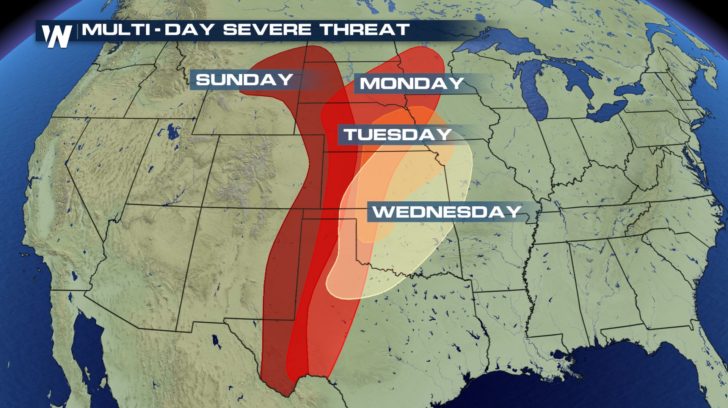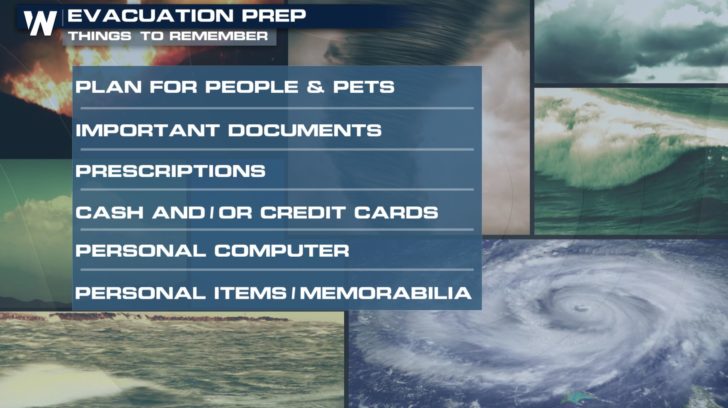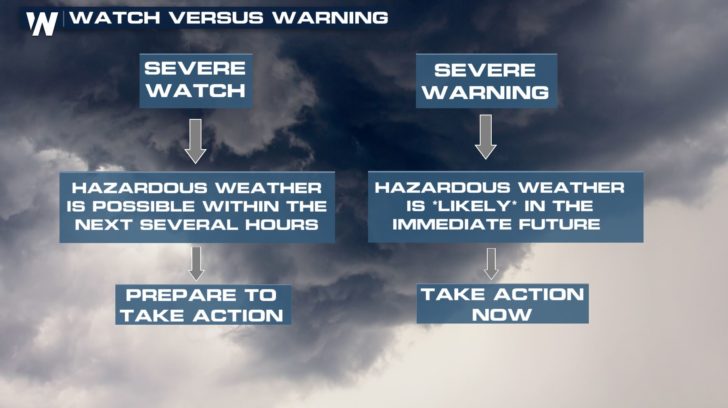So You're in a Severe Risk Area, Now What?
Special Stories
28 Apr 2018 11:41 PM
We have been telling you for days now about the risk of severe weather across the Plains from Sunday to Wednesday. Let's take that forecast to the next level to what we should be doing right now.
Follow and remember these four steps:
 Once again, this is the area where we are watching for severe thunderstorms between Sunday and Wednesday (the 29th to 2nd). We have written extensively about the expectations, locations, and timing with Meteorologist Nick Merianos's story here.
Once again, this is the area where we are watching for severe thunderstorms between Sunday and Wednesday (the 29th to 2nd). We have written extensively about the expectations, locations, and timing with Meteorologist Nick Merianos's story here.
 This can be applied to any natural disaster, whether it be tornadoes, hurricanes, earthquakes, fires, etc. Having your most important personal belongings gathered together is best so you can pick them up and rush out to your safe place quickly. Having storm supplies is great too. This would include bottled water, non-perishable food, battery chargers, a generator with fuel, etc. These are essential because you may not know the next time you'll end up needing them. It's always best to be prepared for the storm and more proactive rather than reactive.
On the day of the storms (for your area) you'll want to monitor the forecast and conditions around you even more than before. Know the difference between a weather WATCH and a weather WARNING.
This can be applied to any natural disaster, whether it be tornadoes, hurricanes, earthquakes, fires, etc. Having your most important personal belongings gathered together is best so you can pick them up and rush out to your safe place quickly. Having storm supplies is great too. This would include bottled water, non-perishable food, battery chargers, a generator with fuel, etc. These are essential because you may not know the next time you'll end up needing them. It's always best to be prepared for the storm and more proactive rather than reactive.
On the day of the storms (for your area) you'll want to monitor the forecast and conditions around you even more than before. Know the difference between a weather WATCH and a weather WARNING.
 We wish you a safe few days ahead and thank you for reading,
For WeatherNation, Meteorologist Steve Glazier
We wish you a safe few days ahead and thank you for reading,
For WeatherNation, Meteorologist Steve Glazier
- Monitor the forecast for your area
- Have a plan in place
- Know where to go
- Prepare any essentials
 Once again, this is the area where we are watching for severe thunderstorms between Sunday and Wednesday (the 29th to 2nd). We have written extensively about the expectations, locations, and timing with Meteorologist Nick Merianos's story here.
Once again, this is the area where we are watching for severe thunderstorms between Sunday and Wednesday (the 29th to 2nd). We have written extensively about the expectations, locations, and timing with Meteorologist Nick Merianos's story here.
- Step One: Monitor the forecast
- Step Two: Have a plan in place
- Step Three: Know where to go
- Step Four: Prepare any essentials
 This can be applied to any natural disaster, whether it be tornadoes, hurricanes, earthquakes, fires, etc. Having your most important personal belongings gathered together is best so you can pick them up and rush out to your safe place quickly. Having storm supplies is great too. This would include bottled water, non-perishable food, battery chargers, a generator with fuel, etc. These are essential because you may not know the next time you'll end up needing them. It's always best to be prepared for the storm and more proactive rather than reactive.
On the day of the storms (for your area) you'll want to monitor the forecast and conditions around you even more than before. Know the difference between a weather WATCH and a weather WARNING.
This can be applied to any natural disaster, whether it be tornadoes, hurricanes, earthquakes, fires, etc. Having your most important personal belongings gathered together is best so you can pick them up and rush out to your safe place quickly. Having storm supplies is great too. This would include bottled water, non-perishable food, battery chargers, a generator with fuel, etc. These are essential because you may not know the next time you'll end up needing them. It's always best to be prepared for the storm and more proactive rather than reactive.
On the day of the storms (for your area) you'll want to monitor the forecast and conditions around you even more than before. Know the difference between a weather WATCH and a weather WARNING.
 We wish you a safe few days ahead and thank you for reading,
For WeatherNation, Meteorologist Steve Glazier
We wish you a safe few days ahead and thank you for reading,
For WeatherNation, Meteorologist Steve GlazierAll Weather News
More